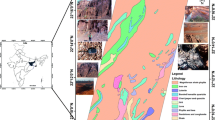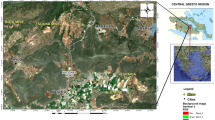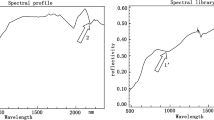Abstract
Banded iron formations (BIFs) represent the most important and widely distributed iron ore resources in the world. Monitoring BIF resources is of great significance for tracking reserves and for the orderly exploitation of resources. Previous remote sensing (RS) recognition methods for ground objects in mining areas have been developed based on satellite sensor data, but those methods do not incorporate the spectral characteristics of ground objects. Consequently, these modeling methods are relatively blind because they do not consider the real spectra of ground objects in advance, affecting the accuracy of RS recognition to a certain degree. In the present study, the visible to near-infrared spectra of two types of typical iron ore (magnetite and hematite) and of the surrounding rocks in a BIF deposit were first recorded by a field-portable spectrometer in a mining area. Then, the differences in the spectral characteristics among the two types of iron ore and surrounding rocks were analyzed. Based on the different spectral characteristics in different wavelength ranges, RS extraction and classification models for iron ore were constructed and applied to Landsat 8 data for the actual recognition of iron ore in an open pit. This study yielded the following results. There were remarkable differences in the spectral characteristics among the two types of iron ore and surrounding rocks. In addition to distinguishing the iron ore from the surrounding rocks, magnetite and hematite were further differentiated based on the constructed inversion model. The accuracies of distinguishing iron ore from the surrounding rocks, identifying hematite, and identifying magnetite were 83.5%, 83.3%, and 85%, respectively. The results demonstrated that iron ore zones can be identified automatically by the RS model based on the measured spectral characteristics and the inversion model. Accordingly, this model can increase the identification accuracy and provide a new method for BIF deposit detection and exploitation monitoring.












Similar content being viewed by others
References
Anderson, A. T., Schultz, D., Buchman, N., & Nock, H. M. (1977). Landsat imagery for surface-mine inventory. Photogrammetric Engineering and Remote Sensing, 43(7), 1027–1036.
Azizi, H., Tarverdi, M. A., & Akbarpour, A. (2010). Extraction of hydrothermal alterations from ASTER SWIR data from East Zanjan, Northern Iran. Advances in Space Research, 46(1), 99–109.
Ciampalini, A., Garfagnoli, F., Antonielli, B., et al. (2013a). Remote sensing techniques using landsat ETM plus applied to the detection of iron ore deposits in Western Africa. Arabian Journal of Geosciences, 6(11), 4529–4546.
Ciampalini, A., Garfagnoli, F., Ventisette, C. D., & Moretti, S. (2013b). Potential use of remote sensing techniques for exploration of iron deposits in Western Sahara and Southwest of Algeria. Natural Resources Research, 22(3), 179–190.
Feizi, F., & Mansouri, E. (2013). Introducing the iron potential zones using remote sensing studies in south of Qom Province, Iran. Open Journal of Geology, 3(4), 278–286.
Guo, N., Chen, J., Tang, J., & Guo, K. (2010). A study of the metallogenic prognosis for the periphery of Jiama copper–polymetallic ore, tibet based on the RS method. Earth Science Frontiers, 17(4), 280–289.
Ma, B. D., Wu, L. X., Zhang, X. X., Li, X. C., Liu, Y., & Wang, S. L. (2014). Locally adaptive unmixing method for lake-water area extraction based on MODIS 250 m bands. International Journal of Applied Earth Observation and Geoinformation, 33(1), 109–118.
Mao, Y. C., Ma, B. D., Liu, S. J., Wu, L. X., & Zhang, X. X. (2014). Study and validation of a remote sensing model for coal extraction based on reflectance spectrum features. Canadian Journal of Remote Sensing, 40(5), 327–335.
Mao, Y. C., Wang, D., Wang, Y., & Liu, S. J. (2018). A FeO/TFe determination method of BIF based on the visible and near-infrared spectrum. Spectroscopy and Spectral Analysis, 38(3), 765–770.
Parks, N. F., Peterson, G. W., & Baumer, G. M. (1987). High resolution remote sensing of spatially and spectrally complex coal surface mines of Central Pennsylvania: A comparison between simulated SPOT MSS and Landsat-5 thematic mapper. Photogrammetric Engineering and Remote Sensing, 53(4), 415–420.
Pour, A. B., & Hashim, M. (2012). The application of ASTER remote sensing data to porphyry copper and epithermal gold deposits. Ore Geology Reviews, 44(1), 1–9.
Pour, A. B., Hashim, M., & Marghany, M. (2011). Using spectral mapping techniques on short wave infrared bands of ASTER remote sensing data for alteration mineral mapping in SE Iran. International Journal of Physical Sciences, 6(4), 917–929.
Prakash, A., & Gupta, R. P. (1998). Land-use mapping and change detection in a coal mining area: A case study in the Jharia coalfield, India. International Journal of Remote Sensing, 19(3), 391–410.
Rajendran, S., Shirbash, S., Pracejus, B., et al. (2012). ASTER detection of chromite bearing mineralized zones in Semail Ophiolite Massifs of Northern Oman mountains: Exploration strategy. Ore Geology Review, 44(2), 121–135.
Rathore, C. S., & Wright, R. (1993). Monitoring environmental impacts of surface coal mining. International Journal of Remote Sensing, 14(6), 1021–1042.
Rigina, O. (2002). Environmental impact assessment of the mining and concentration activities in the Kola Peninsula, Russia by multi date remote sensing. Environmental Monitoring and Assessment, 75(1), 11–33.
Rogge, D., Rivard, B., Segl, K., Grant, B., & Feng, J. (2014). Mapping of NiCu–PGE Ore hosting ultramafic rocks using airborne and simulated EnMAP hyperspectral imagery, Nunavik, Canada. Remote Sensing of Environment, 152, 302–317.
Salem, S. M., & Gammal, E. (2015). Iron ore prospection East Aswan, Egypt, using remote sensing techniques. Egyptian Journal of Remote Sensing and Space Sciences, 18(2), 195–206.
Salem, S. M., Gammal, E., & Soliman, N. M. (2013). Morphostructural record of iron deposits in Paleosols, Cretaceous Nubia sandstone of Lake Naser basin, Egypt, Western Desert, Egypt. Egyptian Journal of Remote Sensing and Space Sciences, 16(1), 71–82.
Schmidt, H., & Glasser, C. (1998). Multi temporal analysis of satellite data and their use in the monitoring of the environmental impacts of open cast lignite mining areas in eastern Germany. International Journal of Remote Sensing, 19(12), 2245–2260.
Song, L., Liu, S. J., Yu, M. L., Mao, Y. C., & Wu, L. X. (2017). A Classification method based on the combination of visible, near-infrared and thermal infrared spectrum for coal and gangue distinguishment. Spectroscopy and Spectral Analysis, 37(2), 416–422.
Tangestani, M. H., & Moore, F. (2001). Comparison of three principal component analysis techniques to porphyry copper alteration mapping a case study: Meiduk Area, Kerman, Iran. Canadian Journal of Remote Sensing, 27(2), 176–182.
Acknowledgements
This research is jointly supported by the National Key Research and Development Projects of China (Grant No. 2016YFC0801602). We would like to thank the Anshan Iron and Steel Group Corporation for providing samples and actual production data and the USGS for providing the Landsat 8 OLI satellite data.
Author information
Authors and Affiliations
Corresponding author
Additional information
Publisher's Note
Springer Nature remains neutral with regard to jurisdictional claims in published maps and institutional affiliations.
About this article
Cite this article
Mao, Y., Wang, D., Liu, S. et al. Research and Verification of a Remote Sensing BIF Model Based on Spectral Reflectance Characteristics. J Indian Soc Remote Sens 47, 1051–1061 (2019). https://doi.org/10.1007/s12524-019-00965-z
Received:
Accepted:
Published:
Issue Date:
DOI: https://doi.org/10.1007/s12524-019-00965-z




